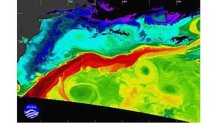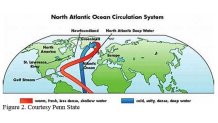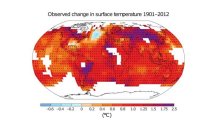You may have heard about it because of the popular 2004 movie “The Day After Tomorrow”. The Gulf Stream off the East Coast stops, and the North Atlantic cools off faster than taking the “Polar Bear Plunge” on New Year’s Day. Of course, the movie is a wild, ridiculous exaggeration, but there is a nugget of science there.

The Gulf Stream is a zone of extra-warm ocean water that extends from just off the Florida east coast to the North Atlantic (the area in red in Figure 1). It’s a permanent feature, although it does move around a bit. The water moves northward, helping to warm both the ocean and even Europe. If the Gulf Stream didn’t exist, Europe would be a LOT colder.
But the Gulf Stream is just a small part of what is known as the AMOC, or Atlantic Meridional Overturning Circulation, which is part of the Great Ocean Conveyor (The ocean circulation then travels all over the globe). As the warm, salty water reaches the far North Atlantic, it cools down. Cooler water sinks, starting the “return” part of the circulation. Figure 2 shows the path for the Atlantic portion of the Great Conveyor.

HOW DO WE KNOW IT IS SLOWING?
Climate models have been predicting a slowing of the AMOC for a long time. In 2015, a paper published by noted climate scientists Stephan Rahmstorf and Michael Mann showed that this slowing had already begun. One piece of evidence stuck out:

Notice anything? That blob of light blue in the North Atlantic represents the ONLY part of the world that actually cooled in the past century or more. That is exactly what would be expected from a weakened AMOC. And a new study by Rahmstorf confirms more than just a slowdown, but evidence the slowdown is happening even more quickly than expected.
Local
Breaking news and the stories that matter to your neighborhood.
WHY SHOULD WE CARE?
A slow-down in the Gulf Stream leads to a warming of the waters to its west. That means off the U.S. East Coast. Warmer waters lead to higher sea levels, and this is probably why sea level is rising here more than just about any other part of the earth. Higher sea levels mean more frequent coastal flooding. It also means any given storm now will cause worse coastal flooding than it would have decades ago. And in the future, the coastal floods will be even worse.
A warmer ocean near us can also help prevent tropical storms and hurricanes from weakening as they get closer. Climate models show this as well: a greater percentage of hurricanes form and track farther north as oceans warm. Superstorm Sandy had record warm ocean temperatures in its path northward in the Atlantic, which probably helped prevent weakening. Expect more of that in the future.
And a warmer ocean leads to more moisture in the atmosphere. That can result in heavier rains in coastal storms, and even heavier snows if it is just cold enough for snow.



